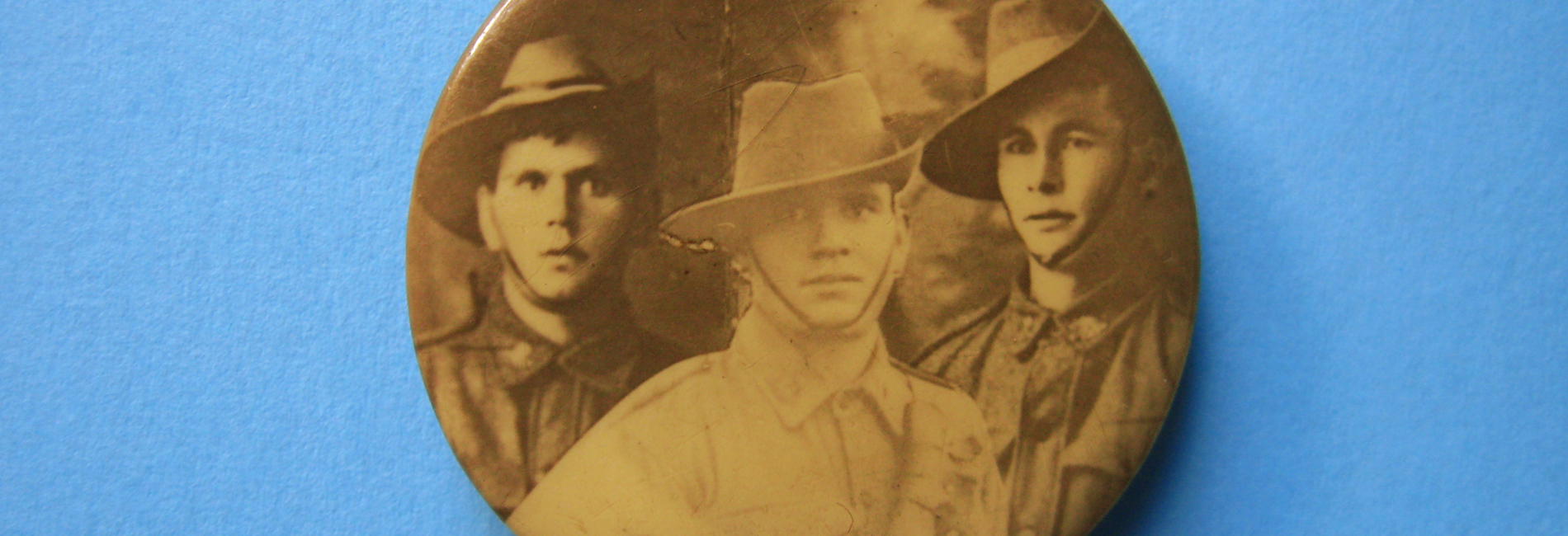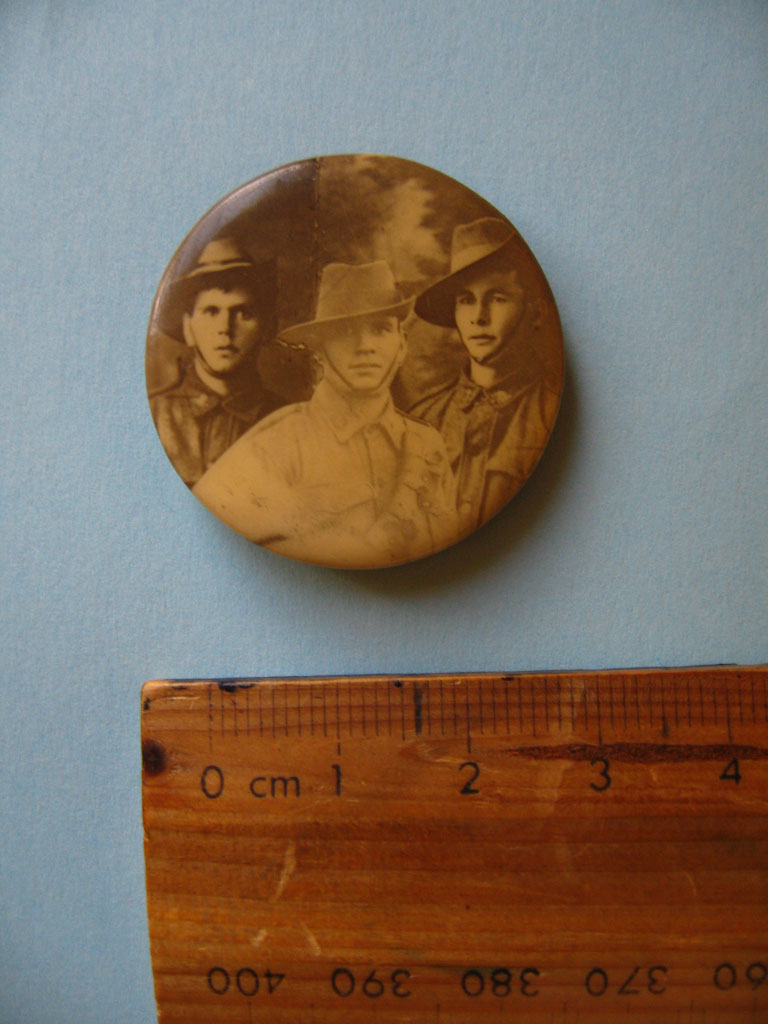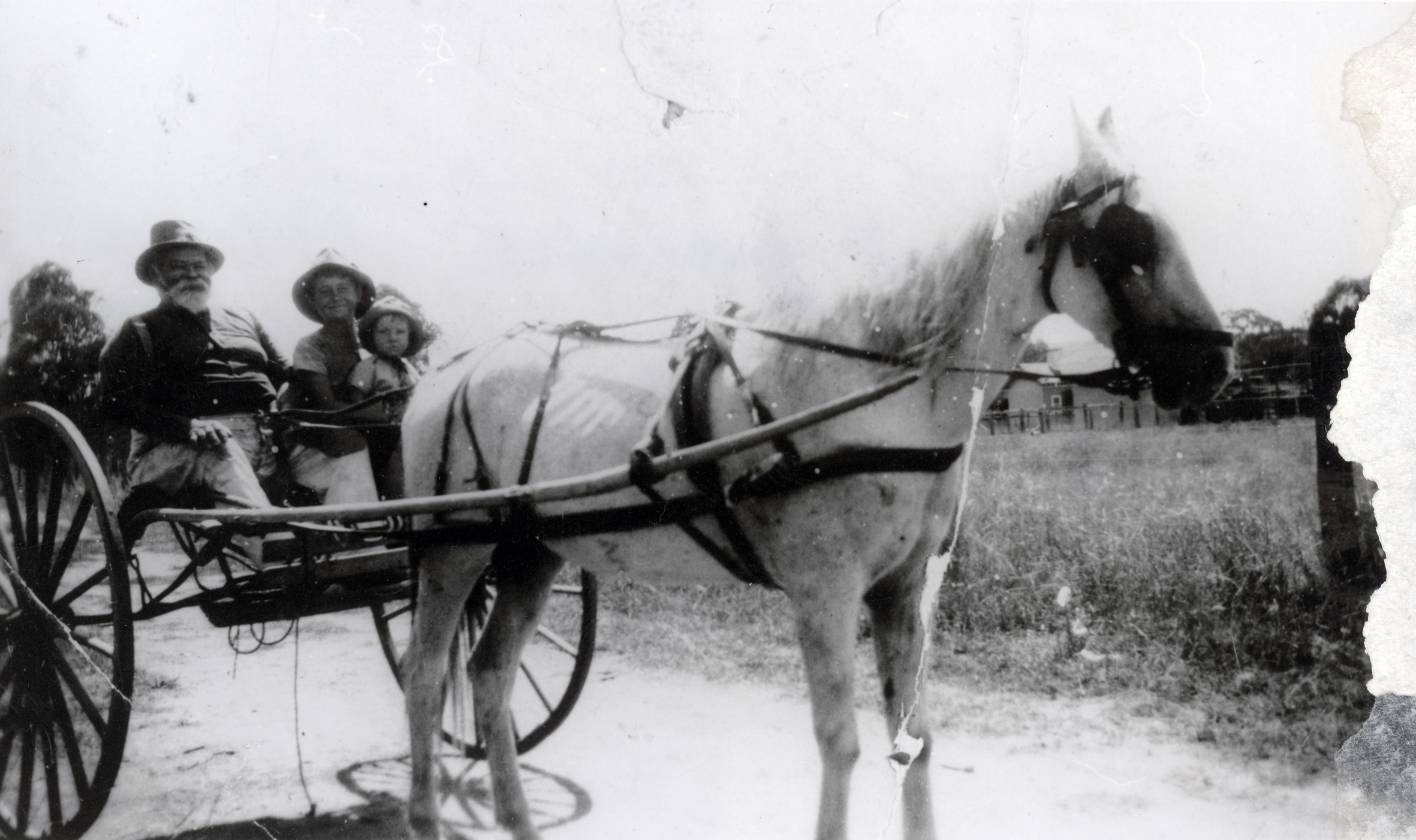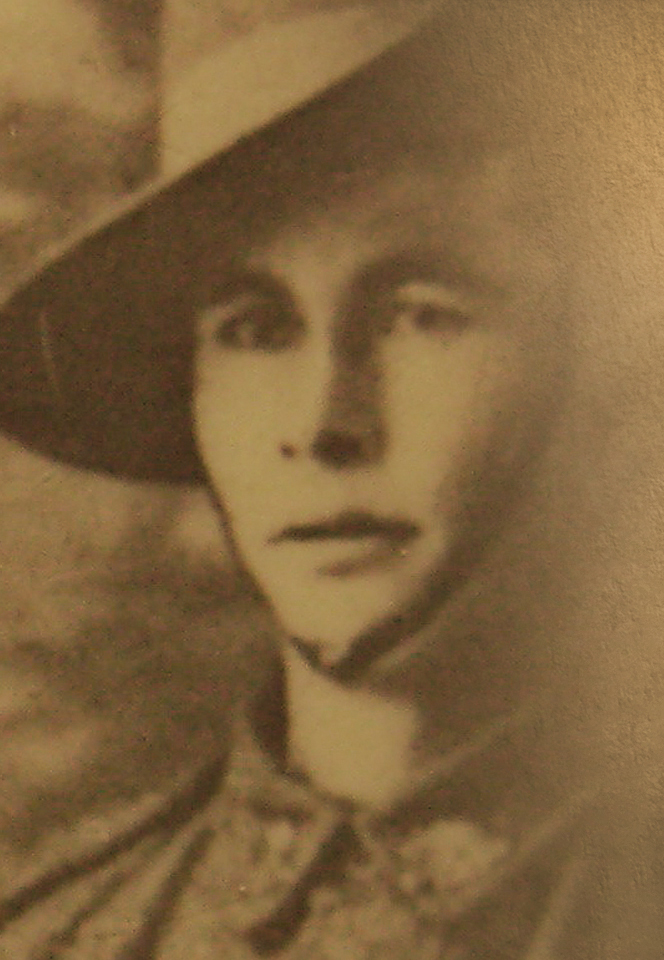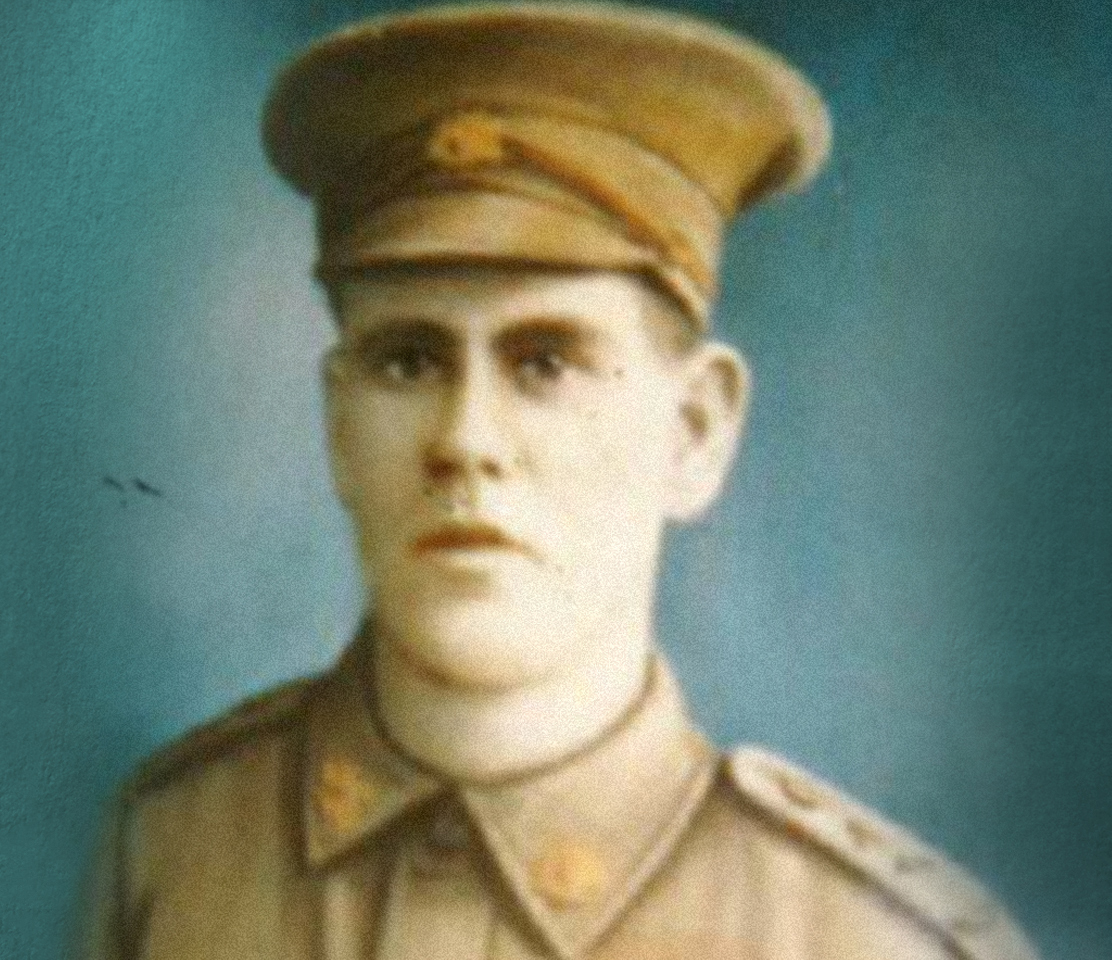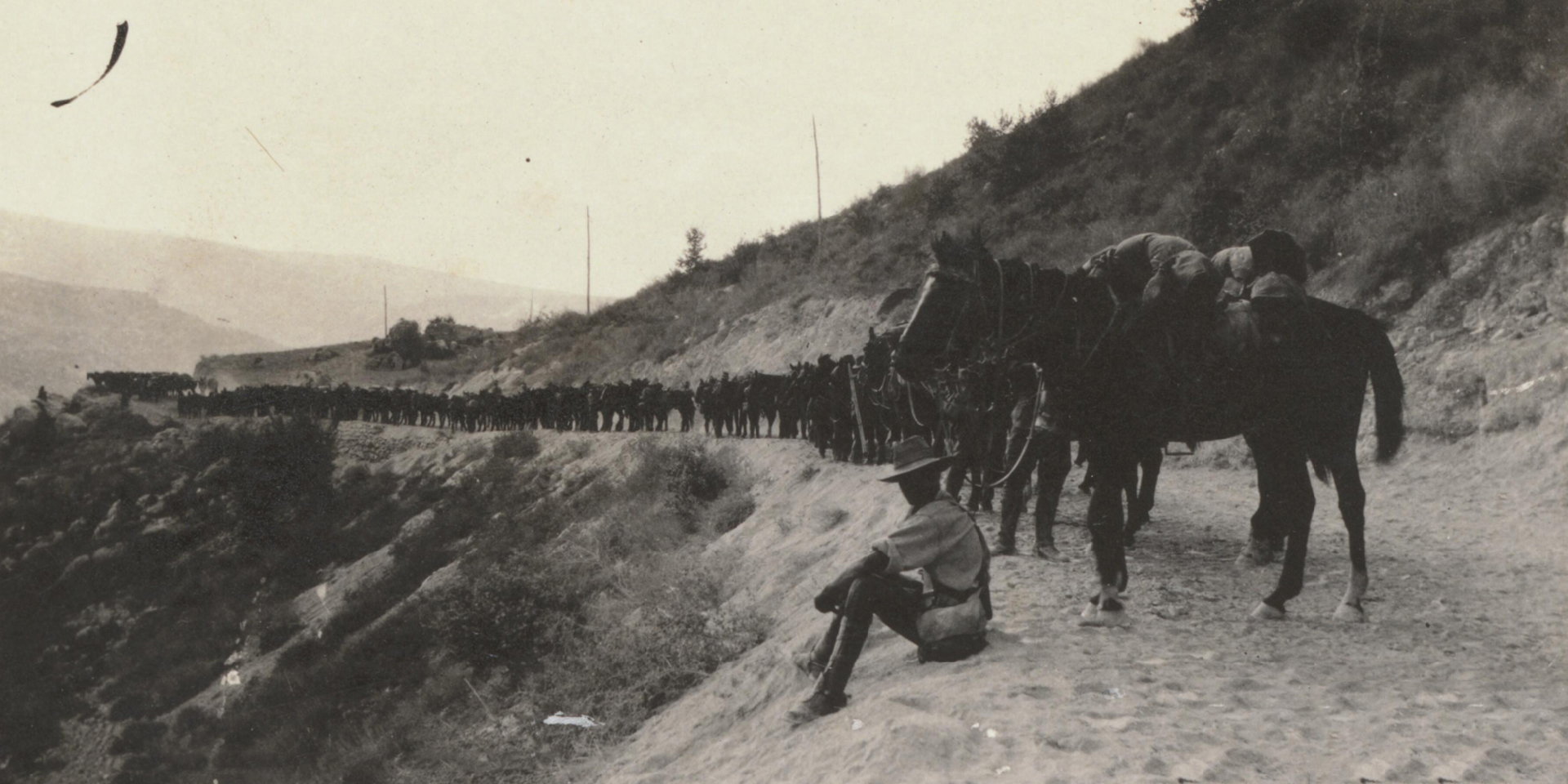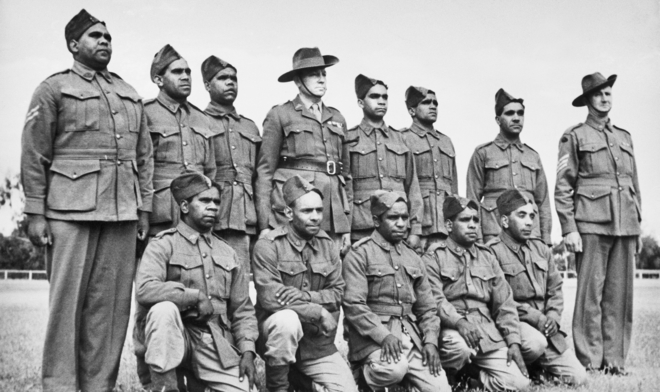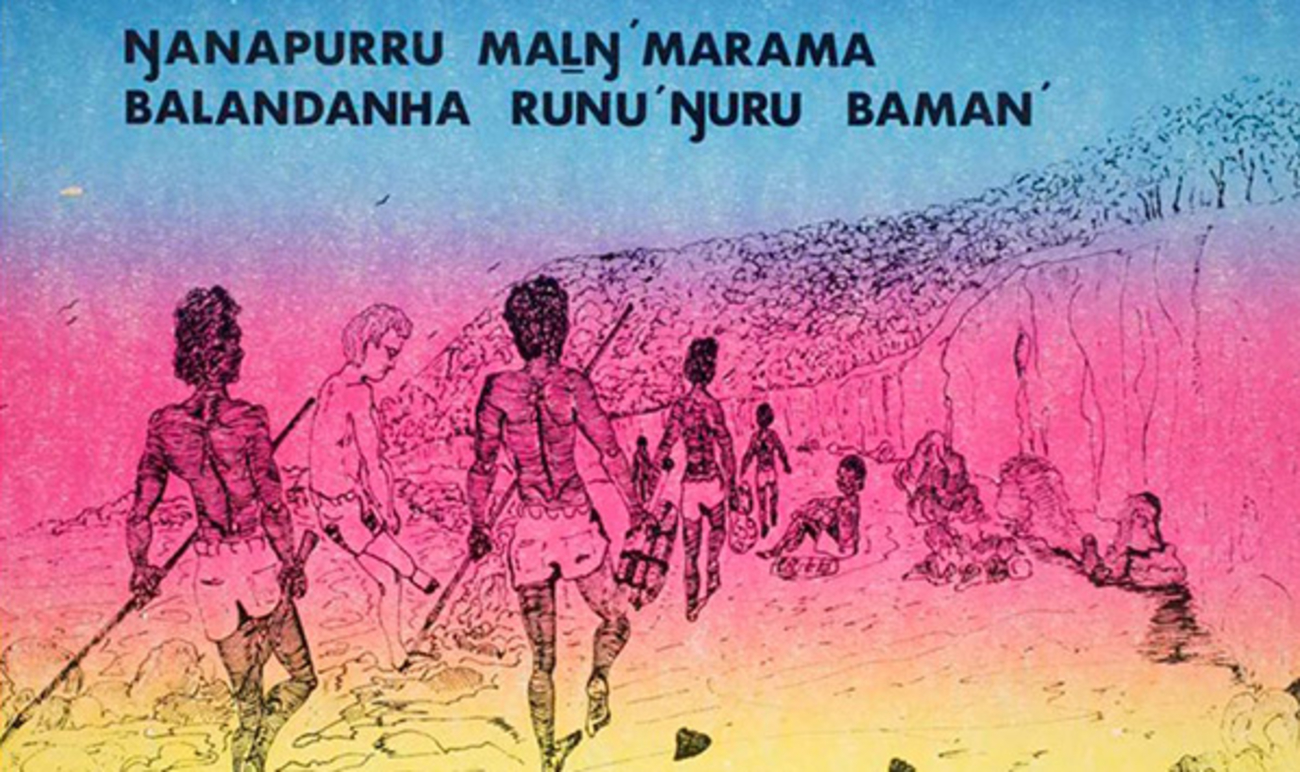From 1915 to 1918, three brothers from the Stafford family – Charles Fitzroy, Clyde Gilford Ortley and John Harold, enlisted and served in the Australian Light Horse as part of the Australian Imperial Force (AIF) in the First World War.
Descendants of Darug (Warmuli Clan)/Gamilaroi peoples, the brothers distinguished themselves as excellent horsemen. For their service, all three brothers were awarded the 1914-1915 Star, the British War Medal, the Victory Medal and a King's Certificate of Discharge.
Clyde and Charles Stafford were also awarded a Silver War Badge.
The tinplate badge below of the Stafford brothers is an example of a photomontage, a technique popularised during the First World War. The technique involves the creation of a composite photograph by cutting and joining two or more photographs into a new image.
The badge came from a time when a mother wore a visual representation of pride and honour for a son or sons serving in war. It was perhaps a way of keeping a son close to a mother’s heart.
The Australian Imperial Force
The first AIF was the main expeditionary force of the Australian Army during the First World War. It was a voluntary force and initially comprised of one infantry division and one light horse brigade.
The AIF expanded and by the end of the First World War it had gained a reputation as being a well-trained and highly effective military force that played a significant role in the final allied victory. This reputation came at a heavy human cost with the casualty rate among the highest.
Aboriginal and Torres Strait Islander men were accepted to the AIF — their racial background overlooked if they had not lived in a ‘tribal’ environment.
During the latter part of the First World War when casualty figures reflected the intensity of the war and recruitment figures began to fall, a military board directive declared that: ‘Half-castes may be enlisted in the Australian Imperial Force provided that the examining Medical Officers are satisfied that one of the parents is of European origin.’
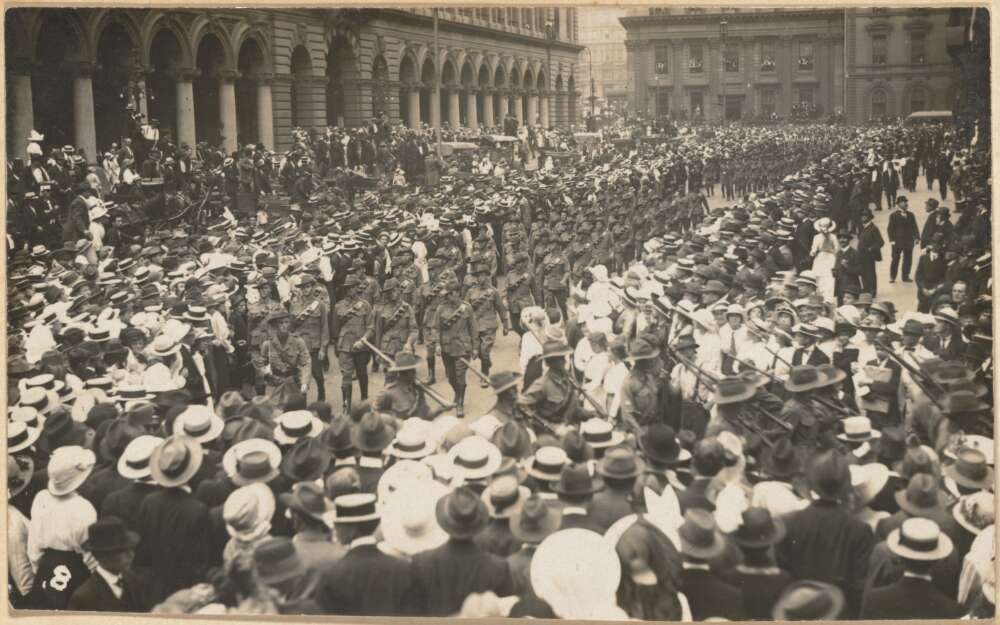
Australian troops marching in Martin Place, Sydney, 1914. Guy Herwald Parker’s personal photograph album, World War 1, 1914-1918, Courtesy of the National Library of Australia.
Australian troops marching in Martin Place, Sydney, 1914. Guy Herwald Parker’s personal photograph album, World War 1, 1914-1918, Courtesy of the National Library of Australia.
The AIF Australian Light Horse
The Australian Light Horse (ALH) holds a revered, almost mythical place in the hearts and minds of Australians. It has been immortalised in poetry, song and films such as the 1987 film The Lighthorsemen.
The first Light Horse Regiment was put together with recruits from New South Wales in 1914. It was one of three regiments of the first Light Horse Brigade – the first mounted formation committed by Australia to the First World War.
The Stafford Family
The Stafford brothers are descended from a Cannemegal (Warmuli) woman called Black Kitty who was placed in the Parramatta Native Institution in 1814 at the age of five.
The Parramatta Native Institution was established by NSW Governor Macquarie to assimilate Aboriginal children, educate, train and Christianise them into colonial societal standards. Once the children were sent to the institution they were not allowed to return to their parents or to their lives they once knew.
Kitty first married Boorooberongal man Colebee, who had been granted land in the Richmond area of NSW. In 1831, Kitty is mentioned in a blanket list as being widowed in her twenties and living in Richmond.
The blanket list
Aboriginal people normally wore animal skin cloaks, the main form of warmth and insulation from the cold. These cloaks would take a year or more to make and were much warmer than the blankets. Nevertheless, Governor Macquarie initiated the distribution of blankets to Aboriginal people in the hope their adoption of blankets would encourage civilised habits and cooperation. So began the blanket list.
They had six children, one of whom was Catherine Budsworth, born in 1832 on the Liverpool Plains. The family then moved to the Maitland area. In 1832 Kitty married English convict Joseph Budsworth (aka Henry Joseph Budsworth). Joseph had been assigned to Magistrate William Cox in 1829 in Clarendon and it may have been this connection that led him to meet Kitty.
In 1852, Catherine Budsworth married Joseph Stafford, an Irish convict from Cork who had been assigned to James Hale’s Bomera Station, located at the foot of the Warrumbungle range north of Coolah. They had seven children including John Allan Stafford who was born in 1857; he was also known as John Allen Stafford.
In 1865, Mary Ann of the Gamilaroi people was born in Binnaway to Anna Mahan and Thomas Henry Blackman or Captain Blackman, as he was known. Blackman was an Aboriginal man and was the son of doctor and farmer, Thomas Blackman and Aboriginal woman Mary Ann.
In 1884, Mary Ann and John Allen Stafford married in Coonabarabran. They had 12 children including Charles Fitzroy, Clyde Gilford and John Harold.
Charles Fitzroy Stafford
(b. 22 October 1890 d. 6 March 1954)
Charles Fitzroy Stafford enlisted on 12 February 1915 aged twenty five. His unit was the 12th Australian Light Horse Regiment, A Squadron, which was part of the 4th Light Horse Brigade.
At the time of enlistment he was a Farrier (Horse-Smith) and was given the rank of Shoeing Smith. During his training, and prior to his embarkation, Charles was promoted to Shoeing Smith Corporal.
The Regiment sailed from Australia in two contingents. On 13 June 1915, Charles embarked with his contingent from Sydney on HMAT A29 Suevic. The ship arrived in Aden, located in the south of modern-day Yemen, on 12 July 1915. This contingent was to reinforce the British garrison against a predicted enemy attack. However, they left Aden for Egypt on 18 July without having seen any action.
The two contingents were reunited in Egypt on 23 July. They trained in an infantry role as they had been ordered to leave their horses in Australia. A month later it deployed to Gallipoli.
The regiment was split up again to reinforce the light horse regiments already at Gallipoli. On 3 October, Charles, who was on A Squadron, went to the 1st Light Horse Regiment. The squadron mainly carried out defensive duties before leaving with the last ANZACs who evacuated Gallipoli on 19-20 December 2015.
On 21 February 1916, suffering from mumps, Charles was admitted to the 4th Auxiliary Hospital in Cairo. This could have been life threatening as more soldiers died of communicable and respiratory diseases than gunshot wounds. He remained in hospital for three weeks.
On 12 March, he was reabsorbed into the 12th Light Horse Regiment in a mounted role, and in May he joined the forces defending the Suez Canal. In April 1917, he was deployed to Palestine taking part in the ill-fated second battle of Gaza.
After the second battle of Gaza and in the summer months, the mounted troops were in constant reconnaissance in preparation for the offensive to come. During this period Charles sustained a broken forearm while shoeing a horse.
This injury would continue to trouble him, resulting in three separate hospital admissions and impairing his ability to grasp.
In what was to become collectively known as the third battle of Gaza, the Battle of Beersheba took place on 31 October 1917. The final phase of this all day battle was the famous mounted charge of the 4th Light Horse Brigade, storming through the Turkish defence and seizing the strategic town of Beersheba. Despite his injury, Charles stayed steadfast to his fellow troopers in what is remembered as the last great calvary charge of Beersheba.
After the fall of Gaza on 7 November 1917, the men of the 12th Light Horse Regiment spent the first few months of 1918 resting and training. The regiment moved again, taking part in the Es Salt Raid, manning defences on the West side of the Jordan River.
In August of 1918, the regiment was issued with swords and trained in traditional cavalry tactics in preparation for the next offensive against the Turks. The objective was to enter Damsascus with Charles’ regiment one of the first Australian units to enter. The regiment was on its way to Homs when the Turks surrendered.
On 30 October 1918, representatives of Great Britain and the Ottoman Empire signed an armistice treaty, marking the end of Ottoman participation in the war.
While waiting to go home, the 12th Light Horse Regiment were called back to operational duty to subdue the Egyptian uprising that erupted in March 1919. Charles served alongside his younger brother John Harold Stafford. This would be Charles’ last deployment and John’s first.
In May 1919, just prior to his return to Australia, Charles contracted malaria. He finally embarked for home aboard HT Dunluce Castle on 17 July 1919 from Suez, Egypt. He was discharged from military service on 21 November 1919.
In 1927, Charles married Phyllis Beggs in Gunnedah and they had one child. He worked for the Liverpool Plains Shire Council for most of his life.
At age 64 Charles Fitzroy Stafford passed away. A well-known and highly respected member of the Gunnedah community, he was accorded a military funeral.
Charles is buried at the Gunnedah Cemetery in New South Wales.
Clyde Gilford Ortley Stafford
(b. 20 April 1894 d. 22 June 1947)
Clyde Gilford Ortley Stafford enlisted on 15 February 1917 aged twenty two. He joined the 1st Light Horse Regiment, 25th Reinforcement as a Private.
On 10 May 1917, Clyde embarked with the unit from Melbourne on the HMAT A42 Boorara.
Clyde participated in the first Amman raid between 22 March and 30 March of 1918. The intention was to inflict casualties on Turkish forces and sever railway communications with Damascus. During the raid, the village of Es Salt was occupied. Fierce fighting continued for two days causing serious damage on the railway. However the Turkish resistance was so strong that the British forces withdrew.
Clyde was wounded on 23 March 1918. He was not evacuated and remained on operational duties.
On 7 October, Clyde was made a lieutenant and driver in the Light Horse Field Ambulance. As a driver he had a dangerous and precarious position, having to rescue and evacuate the wounded while being shot at. This may have been the reason he reverted to being a trooper at his own request in November 1918.
Clyde’s unit was also involved in the third battle of Gaza, whose aim was to divert Turkish attention away from British forces and the Battle of Beersheba on 31 October 1917. Gaza fell to the British on 7 November 1917.
Just like his older brother Charles, Clyde contracted mumps in 1917 and then malaria in 1918. He suffered severely from the diseases and was incapacitated as a result.
On 13 March of 1919, Clyde embarked for return to Australia aboard HT Ulimaroa from Kaliptara, Egypt.
In 1920, Clyde married Jean Annie McInnes in Burwood, Sydney. They had nine children. Clyde worked as a senior fitter repairing train engines in Binnaway.
He was affectionately called Gundy and was a happy giant and perfectionist in his job.
Clyde died in Belmore, Sydney aged 53 on 22 June 1947.
John Harold Stafford
(b. 1 Nov 1897 d. 4 June 1929)
John Harold Stafford was 20 years old when he first tried to enlist. He was rejected on the grounds of being 'medically unfit'. He had scars on his back and leg which may have been the result of working as a shearer and farm labourer.
On 23 July 1918, now aged 21, he enlisted again and joined the 14th Australian Light Horse Regiment as a Private.
The Regiment formed in Palestine in June 1918 and included former Imperial Camel Corps (ICC) alongside horse-mounted troopers. The 14th Regiment joined with the 15th Regiment and a regiment of French colonial cavalry to form the 5th Light Horse Brigade.
John departed from Sydney on HMAT Malta on 16 October 1918 and disembarked in Suez, Egypt on 22 November 1918.
While the 5th Light Horse Brigade fought only in one major battle – the Battle of Megiddo – by the time John arrived in Egypt it was all over and Turkey had already surrendered.
Just as the 14th Australian Light Horse Regiment was getting ready to return to Australia they were called back to operational duty to subdue the Egyptian uprising that started in March 1919. This is the only operation that John was involved in.
On 24 July 1919, John with his regiment sailed from Kantara on 24 July 1919 aboard the HT Dongola. They arrived back in Australia on 28 August 1919.

The 14th and 15th Australian Light Horse Regiments embarking at the termination of their service in Sinai, Palestine and Syria. The men were transferred to Egypt where they were detained during an uprising early in 1919, returning to Australia when this had subsided. Courtesy of the Australian War Memorial.
The 14th and 15th Australian Light Horse Regiments embarking at the termination of their service in Sinai, Palestine and Syria. The men were transferred to Egypt where they were detained during an uprising early in 1919, returning to Australia when this had subsided. Courtesy of the Australian War Memorial.
As a result of a termination of his enlistment period, John was discharged on 13 September 1919.
John remained unmarried and returned to shearing and caring for his ageing parents – John Allen and Mary Ann Stafford.
While out in a paddock in 1929, he tripped over a log and sustained a broken neck, dying as a result.
John is buried in the Binnaway Cemetery with his father, who died not long after.
Service in the First World War
According to the Australian War Memorial, the number of Aboriginal and Torres Strait Islander men who enlisted in the Australian Imperial Force in the First World War stands at 823, other estimates put the total figure between 1000 and 1200.
Aboriginal and Torres Strait Islander men served in practically all branches and units of the AIF: infantry, light horse, artillery, engineers and the flying corps.
Many of the servicemen won a number of decorations for gallantry, including four Distinguished Conduct Medals and 17 Military Medals.
Read more about Aboriginal and Torres Strait Islander war service.
The Stafford papers
In August 2014, the Stafford Papers were gifted to AIATSIS. They highlight the remarkable story of Alfred 'Alf' George Stafford, a Gamilaroi and Darug man who was the youngest of twelve children and the brother of Charles, Clyde and John Stafford.
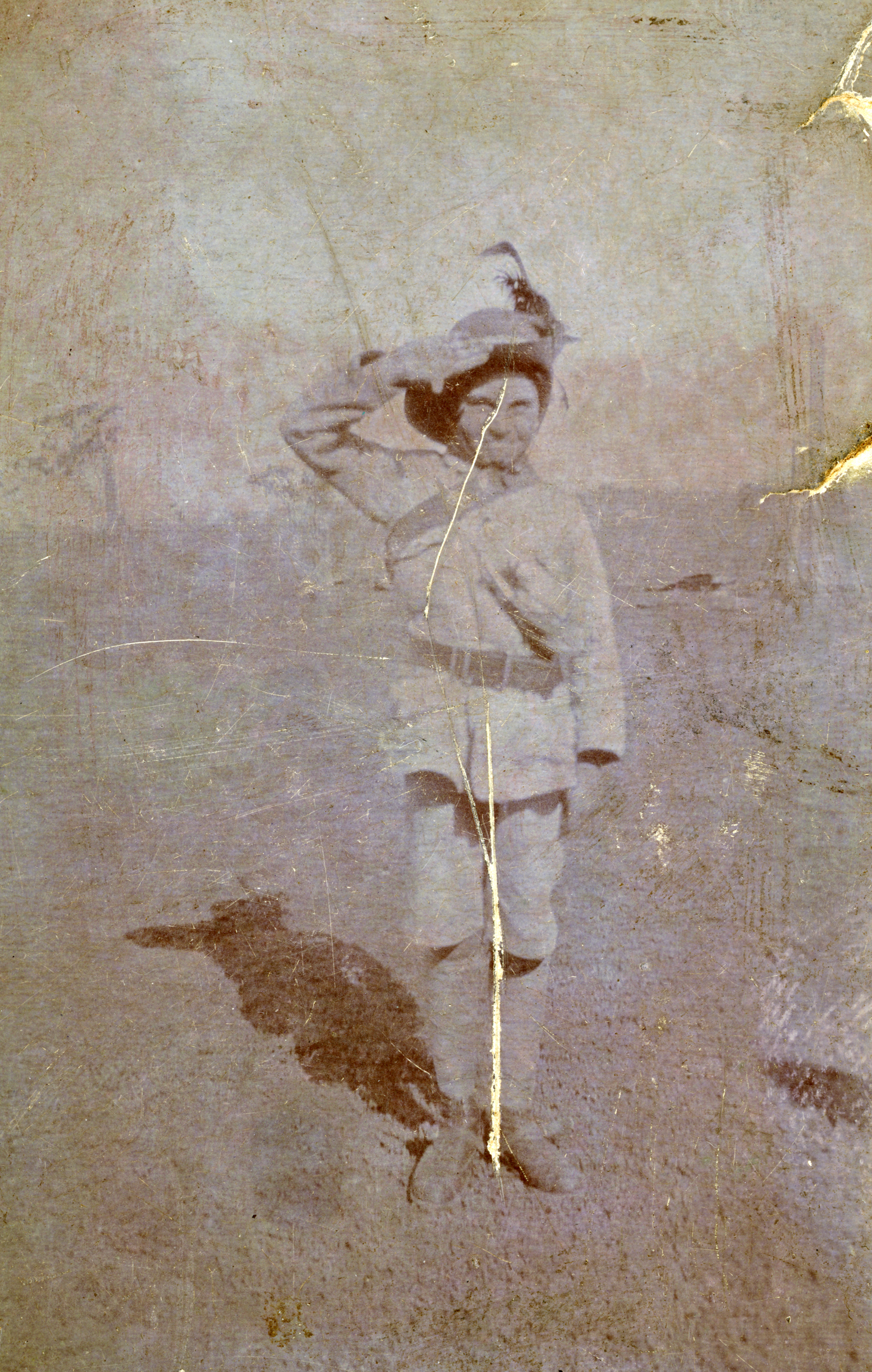
A portrait of Alfred George Stafford, eight years old, saluting and wearing a uniform and slouch hat, c. 1914, Binnaway, NSW. AIATSIS Collection STAFFORD.A01.DF-D00026106.
A portrait of Alfred George Stafford, eight years old, saluting and wearing a uniform and slouch hat, c. 1914, Binnaway, NSW. AIATSIS Collection STAFFORD.A01.DF-D00026106.
The papers shed light on his role in Australia’s political history as a chauffeur to eleven Australian prime ministers. The collection includes personally signed letters and photographs from prime ministers and political figures, material relating to his induction into the Most Excellent Order of the British Empire (MBE), military service and sporting achievements. It also includes genealogical and family history research painstakingly collected by his granddaughter and collection donor Michelle Flynn.
Family information, some photographs and objects for this story are drawn from the Stafford Collection at AIATSIS. We extend our thanks to depositor, Michelle Flynn.
References
The Australian Imperial Force
- Indigenous Australian servicemen, Peter Londey, Australian War Memorial
- Five half-caste brothers enlist, Warrnambool Standard (Vic. : 1914 - 1918), 6 October 1917, p. 3 Edition: DAILY., viewed 12 March, 2015
- Aboriginal Soldier’s Resolve, Aboriginal Evening News (Sydney, NSW : 1869 - 1931), Thursday 30 December 1915, page 4, National Library of Australia
The AIF Australian Light Horse Regiment
The Stafford Family
- A history of Aboriginal Sydney
- Full transcript - Establishment of the Native Institution, 1814
- Cox, William (1764–1837) by Edna Hickson, Australian Dictionary of Biography
- Descendants of Joseph Budsworth
- Walter Coleman: AIF member and Warmuli clan descendant, by Philippa Scarlett, 29 October 2013
The brothers' war service
- First World War Official Histories, Volume I – The Story of ANZAC from the outbreak of war to the end of the first phase of the Gallipoli Campaign, May 4, 1915 (11th edition, 1941)
- 1914-1915 Star, Defence Honours & Awards, Australian Government Department of Defence
- British War Medal 1914-20, Defence Honours & Awards, Australian Government Department of Defence
- Victory Medal, Defence Honours & Awards, Australian Government Department of Defence
Charles Fitzroy Stafford
- Charles Fitzroy STAFFORD, The AIF Project
- 12th Australian Light Horse Regiment, Australian War Memorial
- The charge of the 4th Light Horse Brigade at Beersheba, Robyn Van-Dyk, Tuesday 30 October 2007
- Es Salt Raid, Australian War Memorial
- Attack on Beersheba, Australian War Memorial
- Beersheba The Charge of the 4th Light Horse, 1917, The Australian War Memorial, London
- Ottoman Empire signs treaty with Allies, This Day in History
- NAA B2455, STAFFORD CHARLES FITZROY, Service Record: NAA B2455, Stafford Charles Fitzroy
- The Australian Light Horse Association 2015. 12th Light Horse at Gallipoli
Clyde Gilford Ortley Stafford
- Clyde Gilford Ortley STAFFORD, The AIF Project
- 1919 'Troops on the Ulimaroa.', The Register (Adelaide, SA : 1901 - 1929), 9 April, p. 8, viewed 9 March, 2015
- 1st Light Horse Regiment, 25th Reinforcement, Australian War Memorial
- First Amman Raid, Australian War Memorial 2015
